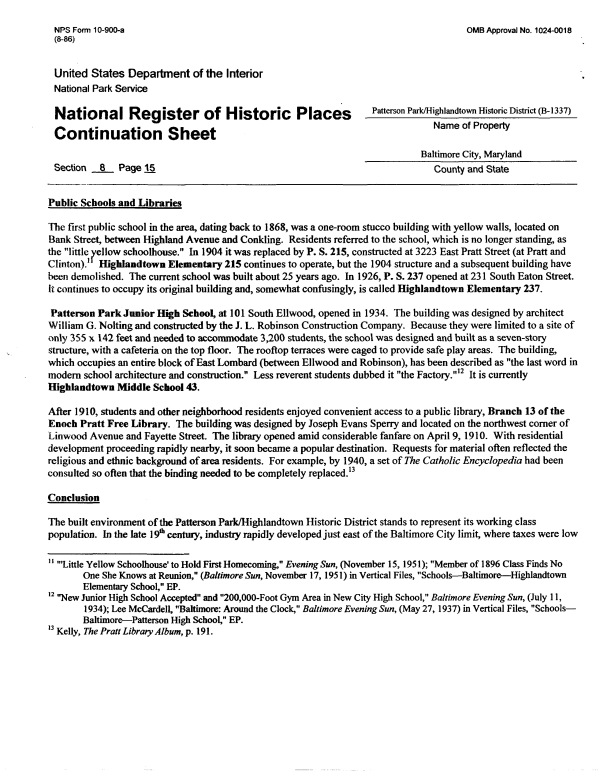 |
||||
|
DEPARTMENT OF HOUSING AND COMMUNITY DEVELOPMENT, MARYLAND HISTORICAL TRUST (Historic Sites Survey) var.d. MSA SE16-3 Image No: se16-3-0110 Enlarge and print image (69K) |
 |
||||
|
DEPARTMENT OF HOUSING AND COMMUNITY DEVELOPMENT, MARYLAND HISTORICAL TRUST (Historic Sites Survey) var.d. MSA SE16-3 Image No: se16-3-0110 Enlarge and print image (69K) |
| NPS Form 1 0-900-a (8-86) OMB Approval No. 1 024-001 8 United States Department of the Interior National Park Service Of A ... . , f^. + Continuation Sheet Section 8 Page 15 PatterSO" Park/Highlandtown Historic District (B-1337) Name of Property Baltimore City, Maryland County and State Public Schools and Libraries The first public school in the area, dating back to 1868, was a one-room stucco building with yellow walls, located on Bank Street, between Highland Avenue and Conkling. Residents referred to the school, which is no longer standing, as the "little yellow schoolhouse." In 1904 it was replaced by P. S. 215, constructed at 3223 East Pratt Street (at Pratt and Clinton). Highlandtown Elementary 215 continues to operate, but the 1904 structure and a subsequent building have been demolished. The current school was built about 25 years ago. In 1926, P. S. 237 opened at 231 South Eaton Street. It continues to occupy its original building and, somewhat confusingly, is called Highlandtown Elementary 237. Patterson Park Junior High School, at 101 South Ellwood, opened in 1934. The building was designed by architect William G. Nolting and constructed by the J. L. Robinson Construction Company. Because they were limited to a site of only 355 x 142 feet and needed to accommodate 3,200 students, the school was designed and built as a seven-story Structure, with a cafeteria on the top floor. The rooftop terraces were caged to provide safe play areas. The building, which occupies an entire block of East Lombard (between Ellwood and Robinson), has been described as "the last word in modern school architecture and construction." Less reverent students dubbed it "the Factory."12 It is currently Highlandtown Middle School 43. After 1910, students and other neighborhood residents enjoyed convenient access to a public library, Branch 13 of the Enoch Pratt Free Library. The building was designed by Joseph Evans Sperry and located on the northwest corner of Linwood Avenue and Fayette Street. The library opened amid considerable fanfare on April 9, 1910. With residential development proceeding rapidly nearby, it soon became a popular destination. Requests for material often reflected the religious and ethnic background of area residents. For example, by 1940, a set of The Catholic Encyclopedia had been consulted so often that the binding needed to be completely replaced.13 Conclusion The built environment of the Patterson Park/Highlandtown Historic District stands to represent its working class population. In the late 19th century, industry rapidly developed just east of the Baltimore City limit, where taxes were low 1' '"Little Yellow Schoolhouse' to Hold First Homecoming," Evening Sun, (November 15,1951); "Member of 1896 Class Finds No One She Knows at Reunion," (Baltimore Sun, November 17, 1951) in Vertical Files, "Schools—Baltimore—Highlandtown Elementary School," EP. 12 "New Junior High School Accepted" and "200,000-Foot Gym Area in New City High School," Baltimore Evening Sun, (July 11, 1934); Lee McCardell, "Baltimore: Around the Clock," Baltimore Evening Sun, (May 27, 1937) in Vertical Files, "Schools— Baltimore—Patterson High School," EP. 13 Kelly, The Pratt Library Album, p. 191. |